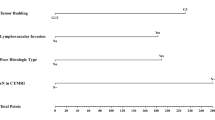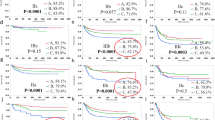Abstract
Purpose
The 9th Japanese Classification of Colorectal Cancer (9th JSCCR) has two main differences from the TNM classification (8th AJCC): first, main or lateral lymph node metastasis is classified as jN3; second, tumor nodules (ND) are treated as lymph node metastasis. In this study, we verified the 9th JSCCR for rectal cancer, focusing on the differences with the 8th AJCC.
Methods
This retrospective analysis involved 212 patients with stage I-III rectal cancer. ND was evaluated using whole-mount sections. We evaluated the relapse-free survival of each staging system, and compared the prognostic significance of the different staging systems using the Akaike information criterion (AIC) and Harrell’s concordance index (c-index).
Results
Main or lateral lymph node metastasis was detected in nine of 212 (4%) patients. ND was detected in 79 of 212 (37%) patients. The best risk stratification power was observed in the 9th JSCCR (AIC, 759; c-index, 0.708) compared with the 7th JSCCR (AIC, 771; c-index, 0.681), 8th JSCCR (AIC, 768; c-index, 0.696), and the 8th AJCC (AIC, 766; c-index, 0.691).
Conclusions
The 9th JSCCR, which includes the concepts of jN3 and ND, is useful for the risk stratification of rectal cancer, and the contributes to precise decision-making for follow-up management and adjuvant therapy.



Similar content being viewed by others
References
Inomata M, Kotake K, Ajioka Y, Kawai K, Ueno H, Goi T, et al., editors. Japanese classification of colorectal, appendiceal, and anal carcinoma. 3rd ed. Kanehara: Tokyo; 2019 (English edition).
Amin MB, Edge S, Greene F, Byrd DR, Brookland RK, Washington MK, et al., editors. AJCC cancer staging manual. 8th ed. New York: Springer International; 2017.
Gunderson LL, Jessup JM, Sargent DJ, Greene FL, Stewart A. Revised tumor and node categorization for rectal cancer based on surveillance, epidemiology, and end results and rectal pooled analysis outcomes. J Clin Oncol. 2010;28:256–63.
Gunderson LL, Jessup JM, Sargent DJ, Greene FL, Stewart AK. Revised TN Categorization for colon cancer based on national survival outcomes data. J Clin Oncol. 2010;28:264–71.
Shinto E, Hida JI, Kobayashi H, Hashiguchi Y, Hase K, Ueno H, et al. Prominent information of jN3 positive in stage III colorectal cancer removed by D3 dissection: retrospective analysis of 6866 patients from a multi-institutional database in japan. Dis Colon Rectum. 2018;61:447–53.
Shinto E, Hida JI, Ike H, Kobayashi H, Hashiguchi Y, Hase K, et al. A new N staging system for colorectal cancer in the era of extended lymphadenectomy. Ann Surg Oncol. 2018;25:3891–7.
Hashiguchi Y, Muro K, Saito Y, Ito Y, Ajioka Y, Hamaguchi T, Japanese Society for Cancer of the Colon and Rectum, et al. Japanese Society for Cancer of the Colon and Rectum (JSCCR) guidelines 2019 for the treatment of colorectal cancer. Int J Clin Oncol. 2020;25:1–42.
Watanabe T, Muro K, Ajioka Y, Hashiguchi Y, Ito Y, Saito Y, Japanese Society for Cancer of the Colon and Rectum, et al. Japanese Society for Cancer of the Colon and Rectum (JSCCR) guidelines 2016 for the treatment of colorectal cancer. Int J Clin Oncol. 2018;23:1–34.
Kanemitsu Y, Komori K, Kimura K, Kato T. D3 lymph node dissection in right hemicolectomy with a no-touch isolation technique in patients with colon cancer. Dis Colon Rectum. 2013;56:815–24.
Kitano S, Inomata M, Mizusawa J, Katayama H, Watanabe M, Yamamoto S, et al. Survival outcomes following laparoscopic versus open D3 dissection for stage II or III colon cancer (JCOG0404): a phase 3, randomised controlled trial. Lancet Gastroenterol Hepatol. 2017;2:261–8.
Sugihara K, Kobayashi H, Kato T, Mori T, Mochizuki H, Kameoka S, et al. Indication and benefit of pelvic sidewall dissection for rectal cancer. Dis Colon Rectum. 2006;49:1663–72.
Akiyoshi T, Watanabe T, Miyata S, Kotake K, Muto T, Sugihara K, Japanese Society for Cancer of the Colon and Rectum. Results of a Japanese nationwide multi-institutional study on lateral pelvic lymph node metastasis in low rectal cancer: is it regional or distant disease? Ann Surg. 2012;255:1129–34.
Fujita S, Mizusawa J, Kanemitsu Y, Ito M, Kinugasa Y, Komori K, Colorectal Cancer Study Group of Japan Clinical Oncology Group, et al. Mesorectal excision with or without lateral lymph node dissection for clinical stage II/III lower rectal cancer (JCOG0212): a multicenter, randomized controlled, noninferiority trial. Ann Surg. 2017;266:201–7.
Ogura A, Konishi T, Cunningham C, Garcia-Aguilar J, Iversen H, Toda S, et al. Neoadjuvant (chemo)radiotherapy with total mesorectal excision only is not sufficient to prevent lateral local recurrence in enlarged nodes: results of the multicenter lateral node study of patients with low cT3/4 rectal cancer. J Clin Oncol. 2019;37:33–43.
Ueno H, Mochizuki H, Akagi Y, Kusumi T, Yamada K, Ikegami M, et al. Optimal colorectal cancer staging criteria in TNM classification. J Clin Oncol. 2012;30:1519–26.
Shimada Y, Takii Y. Clinical impact of mesorectal extranodal cancer tissue in rectal cancer: detailed pathological assessment using whole-mount sections. Dis Colon Rectum. 2010;53:771–8.
Shimada Y, Takii Y, Maruyama S, Ohta T. Intramural and mesorectal distal spread detected by whole-mount sections in the determination of optimal distal resection margin in patients undergoing surgery for rectosigmoid or rectal cancer without preoperative therapy. Dis Colon Rectum. 2011;54:1510–20.
Abe K, Shimada Y, Oyanagi H, Yagi R, Nakano M, Kameyama H, et al. The clinical significance of distal spread differs according to the primary tumor location in rectal cancer. Surg Today. 2019. https://doi.org/10.1007/s00595-019-01882-x.
Akaike H. Information theory and extension of the maximum likelihood principle. In: Kotz S, Johnson NL, editors. Breakthroughs in statistics, vol. 1. Foundations and basic theory. New York: Springer; 1973. p. 610–24.
Harrell FE Jr, Lee KL, Mark DB. Multivariable prognostic models: issues in developing models, evaluating assumptions and adequacy, and measuring and reducing errors. Stat Med. 1996;15:361–87.
Sauer I, Bacon HE. Influence of lateral spread of cancer of the rectum on radicability of operation and prognosis. Am J Surg. 1951;81:111–20.
Heald RJ, Moran BJ. Embryology and anatomy of the rectum. Semin Surg Oncol. 1998;15:66–71.
Ishiguro M, Higashi T, Watanabe T, Sugihara K. Japanese Society for Cancer of the Colon and Rectum Guideline Committee. Changes in colorectal cancer care in japan before and after guideline publication: a nationwide survey about D3 lymph node dissection and adjuvant chemotherapy. J Am Coll Surg. 2014;218:969–77.
National Comprehensive Cancer Network. NCCN clinical practice guidelines in oncology-rectal cancer (version1. 2020). https://www.nccn.org/professionals/physician_gls/pdf/rectal.pdf. Accessed 23 Feb 2020.
Glynne-Jones R, Wyrwicz L, Tiret E, Brown G, Rödel C, Cervantes A, et al. Rectal cancer: ESMO clinical practice guidelines for diagnosis, treatment and follow-up. Ann Oncol. 2017;28(suppl_4):iv22–40.
Goldstein NS, Turner JR. Pericolonic tumor deposits in patients with T3N + MO colon adenocarcinomas: markers of reduced disease free survival and intra-abdominal metastases and their implications for TNM classification. Cancer. 2000;88:2228–38.
Nagtegaal ID, Knijn N, Hugen N, Marshall HC, Sugihara K, Tot T, et al. Tumor deposits in colorectal cancer: improving the value of modern staging—a systematic review and meta-analysis. J Clin Oncol. 2017;35:1119–27.
Fleming ID, Cooper JS, Henson DE. AJCC cancer staging manual. 5th ed. Philadelphia: Lippincott Raven; 1997.
Greene FL, Page DL, Fleming ID, Fritz AG, Balch CM, Haller DG, et al. AJCC cancer staging manual. 6th ed. New York: Springer; 2002.
Edge SB, Byrd DR, Compton CC, Fritz AG, Greene FL, Trotti A. AJCC cancer staging manual. 7th ed. New York: Springer; 2010.
Author information
Authors and Affiliations
Corresponding author
Ethics declarations
Conflict of interest
The authors declare that they have no conflicts of interest in association with this study.
Additional information
Publisher's Note
Springer Nature remains neutral with regard to jurisdictional claims in published maps and institutional affiliations.
Rights and permissions
About this article
Cite this article
Arabiki, M., Shimada, Y., Nakano, M. et al. Verification of the Japanese staging system for rectal cancer, focusing on differences with the TNM classification. Surg Today 50, 1443–1451 (2020). https://doi.org/10.1007/s00595-020-02024-4
Received:
Accepted:
Published:
Issue Date:
DOI: https://doi.org/10.1007/s00595-020-02024-4




